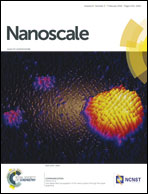Integrated random-aligned carbon nanotube layers: deformation mechanism under compression†
Abstract
Carbon nanotubes have the potential to construct highly compressible and elastic macroscopic structures such as films, aerogels and sponges. The structure-related deformation mechanism determines the mechanical behavior of those structures and niche applications. Here, we show a novel strategy to integrate aligned and random nanotube layers and reveal their deformation mechanism under uniaxial compression with a large range of strain and cyclic testing. Integrated nanotube layers deform sequentially with different mechanisms due to the distinct morphology of each layer. While the aligned layer forms buckles under compression, nanotubes in the random layer tend to be parallel and form bundles, resulting in the integration of quite different properties (strength and stiffness) and correspondingly distinct plateau regions in the stress–strain curves. Our results indicate a great promise of constructing hierarchical carbon nanotube structures with tailored energy absorption properties, for applications such as cushioning and buffering layers in microelectromechanical systems.


 Please wait while we load your content...
Please wait while we load your content...